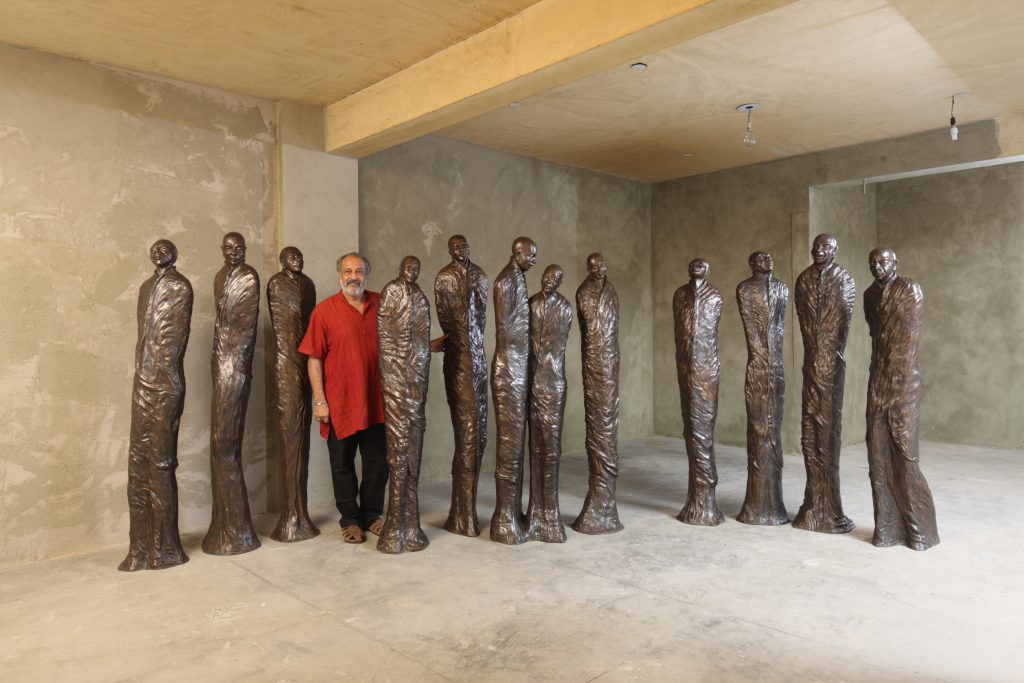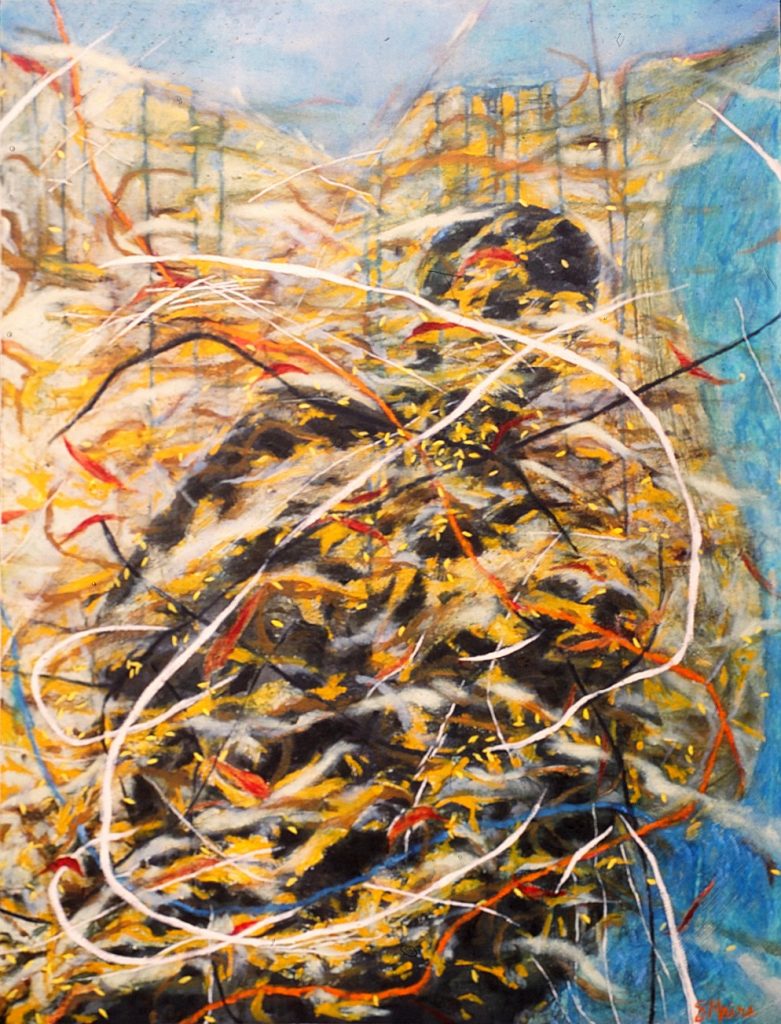It was April 2021 when we wrote to Mr Maira inviting a narrative to feature the inspiration and success of the alumni taking the path less chosen in the ‘Literature, Art and Journalism’ sector. He was the only alumni to have answered the email, and we received this story from him on May 2, 2021 accompanied by an important caveat: “My writing is not to be edited or changed without my explicit approval. Kindly confirm this.” With this, he left us all on May 9, 2021, at the age of 73 in Delhi – with words rooted to realism, an inspiring journey with arts and a multifaceted legacy.

May 2021
I studied at IIMA between 1966 to 1968. Management Control Systems, Marketing and Finance were my concentrations. Prior to that, I had studied Economics at St. Stephen’s College, Delhi University. In school – Mayo College, Ajmer – art and geography had been my favourite subjects. After finishing college I was headed to London for Articleship with Cooper Bros when I heard about the IIMA, and drawn by the excitement of a path less taken, I went there instead. IIMA was an exciting new institution and I was impressed by the faculty who interviewed me and the case method-based learning model. I had nodded off at enough note-taking lectures in college and looked forward to a more dialogical learning method.
At graduation from IIMA, though I had been recruited on campus by Citibank, I elected to take a much lower paying and uncertain job as a junior management consultant at the newly started Management Consultancy Division at A.F. Ferguson’s. It seemed to be the only avenue to working in Management Control Systems at the time. I wonder how many IIMA graduates choose a job or a career where the salary is not the primary criteria for selection, like my classmate and friend, Kiran Karnik.
It only took me a few months to realize that Management Control Systems were neither clear to my employer or its clients. I, therefore, joined Citibank in Mumbai (then Bombay) who renewed their campus offer. Initially, it was an extremely positive experience, but then, while I was in the Philippines gearing up to start Citibank’s finance company in India, Prime Minister Indira Gandhi nationalized a large number of banks and shut down the expansion of foreign bank operations.
In 1972, I quit Citibank and joined Lintas India that had recently been spun-off from HLL and was struggling. I seemed to be the right person at the right time. Initially, I handled Planning and Finance, then added Media and developed India’s first media planning model. This was before the advent of computers. I was on the management committee of Lintas and helped run the company in all aspects. I was well-rewarded. I started and ran Pathfinders, a marketing research and consultancy division. I had the great pleasure to return to IIMA to hire four bright MBAs, all of whom prospered at Lintas and beyond. One of these people was Rama Bijapurkar.
Painting was an activity I had been involved with since childhood. It was something I enjoyed and did well. In school, I was awarded the Senior Art Prize for an unprecedented two years. In college, I won the first prize at the annual university art show. In Bombay, I started painting again, and two paintings were accepted in a group show at Jehangir Art Gallery in 1972. To my surprise and delight, they were both sold. I went on to have five one-person shows at the Taj Art Gallery during my years at Lintas. My work was being positively reviewed and collected.
For those seven years in Mumbai, I was both a successful management professional and an artist. What was my career at that time? Was I an effective and successful business executive? Was I an artist with a growing art practice? I think ‘career’ is the wrong frame to apply in such a situation. Working at Lintas and making art were not ‘career’ choices. I did what I was good at and what I was drawn to do.
In 1979, eleven years after graduating from IIMA, I went to the US and joined the rapidly growing mini computer industry. From 1982 to 1984, I took a leave-of-absence from DEC (Digital Equipment Corporation) and worked for the World Bank as a development consultant in Sri Lanka. On my return to the US, I continued my international marketing ‘career’ and rediscovered my passion for art. I was lucky to be talented at both. I began exhibiting in the US and on occasional visits, in India as well. In 1988, I brought an exhibition titled New Hampshire Drawings to Delhi. To my surprise, the National Gallery of Modern Art, New Delhi, acquired two drawings for their permanent collection. This was a huge honour and validation. In 1990, I quit DEC to change the distribution of my energies between management work and art. I continued to take on small consultancy assignments, but became free of the constraints of structured corporate work life.
We all have different temperaments, and we change too over time. What may absorb us fully at one time, may not at another point in our lives. To the extent we can, we need to move and change our work structures. This will entail challenges and difficulties, but becoming stuck in anything is not a good life choice. I know too many people who have done that and lead relatively well-paid but frustrated lives.
There is a significant point to be made about the narrow silos we are squeezed into. As children, we all had many interests and potentials. But gradually, we were expected, encouraged, pushed by social frameworks to become narrow and specialized. I had a rich childhood and always remained interested and active in many pursuits. Playing sports, travel, music, art and beauty. I have met too many people at my exhibitions who smugly say, ‘I don’t have an artistic bone in my body’. This is of course rubbish. What has happened is a stunting of the natural and innate artistic potential most people are born with.
I returned to live in India in 2001. Over the years I have been in many group shows and have had over thirty one-person shows, including in New York, Boston, Paris and Amsterdam. My work is in many private collections in India and abroad. The two images in this article are from the Sangha Series and ???.
Concerned at the increasing imitative trends in the Indian contemporary art scene, I began writing for newspapers and journals in the early 2000s. I was commissioned by Penguin India to write Towards Ananda: Rethinking Indian Art and Aesthetics (2006). My second book, The Promise of Beauty & Why it Matters (HarperCollins, 2017), was an exploration of beauty through a series of dialogues with scientists, philosophers, artists, neuroscientists, social scientists, environmentalists from India and abroad.
I have been interested and engaged in art education in schools, in the US and in India. Art is a rich learning modality in childhood, and I believe, through our lives. In 2005, I was invited by UNESCO to write a paper on ‘Learning through the Arts in Asia’, which I presented at Seoul, at the UNESCO conference.
I came to IIMA in 2011 and discussed the idea of bringing in the arts for a more well-rounded education. My proposal broadly was to create a forum for students to use the case-method approach to experience, understand and appreciate the arts – literature, classical music, the fine arts. I also wanted the creation of a studio space for pottery, clay sculpture and painting where master artists and craftsmen held workshops. The major resistance to it was that students didn’t have the time for something like this. And, that exactly is the problem. We do not see the value and importance of the arts and what they can teach us about our culture and ourselves. The arts represent the immense evolutionary journey humans have made. Not being alive to the arts is, in my view, a profound ignorance.
I was quite disappointed by the lack of aesthetic vitality at IIMA. It had not been able to sustain the special vision of Loius Kahn and its first director, Ravi Matthai. It looked, and felt, quite ordinary and average.
In my view, we would be much better leaders if we were less narrow and specialized. We would also be enriched by the deepening of our experience and by what the arts can enable in our personal development. I can say with certainty, we would find greater satisfaction and fulfillment in our lives if we actively engaged with the arts. These are not avenues of distraction and entertainment. They are repositories of understanding and wisdom.
Let me end by saying that our choice of career should be broad and encompassing many different aspects of life. We should avoid the dryness of too narrow a specialization and the inevitable stunting of much that makes us special as human beings. We can be good at many things. Over-specialization severely limits us.
My two years at IIMA were very positive for my education and development, especially, in developing my analytical and reasoning skills. We had a great faculty and it was empowering to be treated with equality and respect. I think I am probably the only IIMA graduate who became an artist, educator, philosopher, writer and public speaker in the arts. The range of my interests has been very wide, and I have been fortunate to have done what Joseph Campbell famously advised his students to do: Follow your bliss.
If you want to know more about me and my ‘career’ choices and directions, do visit my website: shaktimaira.com. If nothing else, I was an IIMA alum who took the paths less taken by my tribe.


